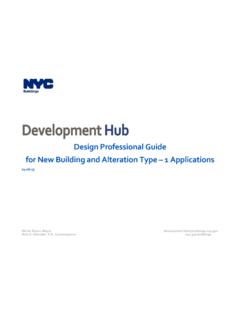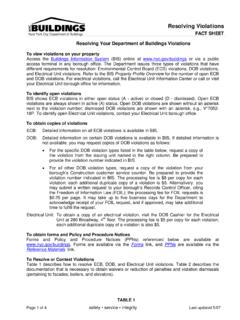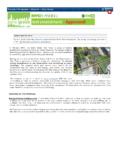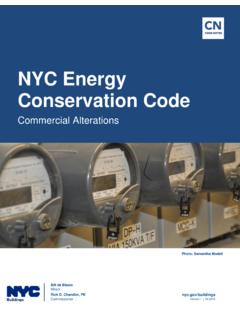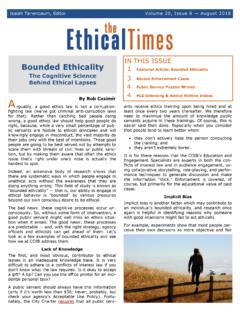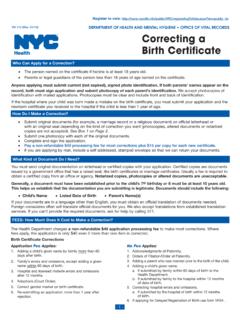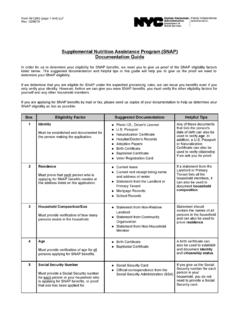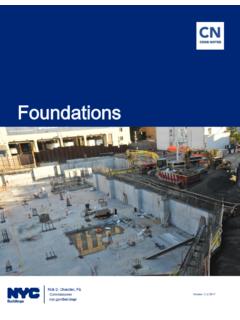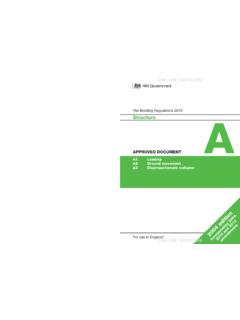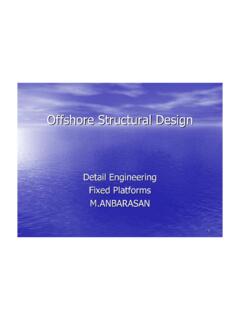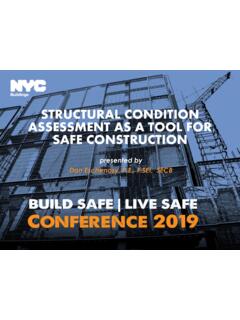Transcription of Underpinning, a calculated approach
1 Underpinning, a calculated approach A presentations intended to provide some useful pointers for engineering calculations of pin-underpinning consistent with the provisions of the new 2014 building Code Dan Eschenasy, PE, Department Chief structural Engineer 3/17/2015 1 Understanding the Application of Some 2014 Code Provisions Underpinning Pit? Pier? Continuous strip? Pin? Classical? 3/17/2015 DESCH -draft 2 FOUNDATION UNDERPINNING AS IT WAS RECOMMENDED IN MANUALS AROUND 1910 SUPPORT OF SOIL SYSTEM WAS SEPARATE FROM UNDERPINNING PIN- Underpinning The following slides look to the engineering calculations aspect of pin underpinning operation and provide some suggestions consistent with the new 2014 code Underpinning consists in the installation of a new foundation under an existing one.
2 These new permanent foundations are installed to support adjoining walls or adjoining buildings . [Adjoining generally means adjoining to excavations, not necessarily on a different lot.] Pin-underpinning is a particular method of underpinning that includes support of excavation sometimes a temporary function. This method is so commonly used in NYC that it usually referred as underpinning. 3/17/2015 DESCH -draft 3 FHWA-RD-75-130 LATERAL SUPPORT SYSTEMS AND UNDERPINNING Shoring presents some special problems. First, when old walls are encountered, it is often not possible to shore these walls without reinforcing the footing.
3 In some cases the entire footing must be rebuilt prior to both shoring and underpinning. In extreme cases entire walls have to be rebuilt. A second consideration is the moment and shear capacity of the walls being underpinned. Asymmetric loading or load concentrations (such as from high capacity underpinning piles) are typical concerns. Lateral support and/or reinforcement is often necessary to alleviate this type of problem. 3/17/2015 DESCH -draft 4 Sources of settlements a. structural Elements. Settlements may be elastic in nature due to an increase in load.
4 Non-elastic deformations may stem from creep and shrinkage of the concrete used for underpinning, as in pit underpinning. b. Bearing Stratum. Settlements are caused by strain within the bearing stratum. c. Construction Procedures. The two main sources of settlement during construction are loss of ground during excavation and the strain associated with load transfer. d. The Structure. The integrity of the existing structure must be considered. Of special interest are old masonry walls, in which briCk and mortar may have seriously deteriorated, and structural members (both walls and columns) that might not withstand the bending moments induced during load transfer.
5 FROM FHWA-RD-75-130 3/17/2015 DESCH -draft 5 Repeated installation of a single pin? The installation of a single pin is mostly a methodology of execution problem. One needs to consider how much the existing foundation can span unaffected when a hole is dug underneath, how to protect the sides of the approach pit, how to pour and connect the pin to the existing foundation. etc. The loads introduced by the installed pin will induce only local effects. The removal of soil for just one pin is not likely to affect the overall pressure on nearby soil.
6 3/17/2015 DESCH -draft 6 Single pin As the depth and the corresponding lateral soil pressure S increase, a single pin, will fail by overturning. The conditions are such that the contractor will not seek to stabilize the pin by increasing the depth of the pin beyond the depth of the existing foundation, B. When connected at the top the pin will be stabilized by the weigh transmitted down from the existing building . 3/17/2015 DESCH -draft 7 Repeated installation of a single pin? In many projects the underpinning of an entire wall is viewed as a repeated installation of a single pin.
7 Unless based on engineering, the simultaneous removal of soil and installation of pins might lead to: Increase in the vertical pressure exerted on the underlying soil, sometimes beyond allowable values. Effects of the lateral soil pressure will additionally increase the vertical pressure on the underlying soil. The soil lateral pressure will affect locally the existing building . 3/17/2015 DESCH -draft 8 Underpinning as support of excavation The repeated one pin approach might misses considering the larger effect on the entire wall or building produced by the installation of a support of excavation system.
8 The sketch shows clearly that at some point in the execution process a support of excavation system is in place. Lateral loads exerted on this support system will induce forces in the existing building wall above and in the foundation bellow. 3/17/2015 DESCH -draft 9 Steps for designing a pin underpining soil bearing capacity and other properties. building (to be underpinned) a)Determine condition of existing building b)Determine potential response of existing building vertical loads on existing foundation dimension of pin (for each phase).
9 The structural model of the underpinned structure that satisfies the known building and soil conditions. strength, sliding and overturning for each element at each phase, including soil carrying capacity. 3/17/2015 DESCH -draft 10 A. Soil properties and capacity From probes and soil report determine soil properties: Soil allowable bearing pressure at existing foundation level Soil allowable bearing pressure after removal of overburden Soil allowable bearing pressure at the base of pin Possible presence and influence of underground water Where tier underpinning is contemplated, soil capacity at each tier bottom needs to be determined.
10 Lateral pressure exerted by soil at pin level. Note that the type of lateral pressure exerted by the soil that is used in calculations needs to be considered in conjunction with the capacity of the existing building to suffer some deformations. 3/17/2015 DESCH -draft 11 Active vs At Rest Soil Pressure One needs to be aware that the active soil pressure is a lower boundary of the soil lateral pressure ( that is, higher lateral pressures might develop). These values can be used assuming that some rotation or displacement may take place ( that is, the wall system has some flexibility) In some particular cases, some minor rotation or displacement might be accommodated (elastically?)
